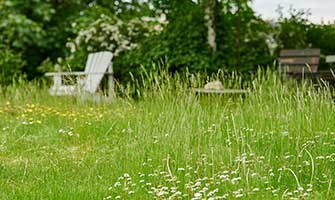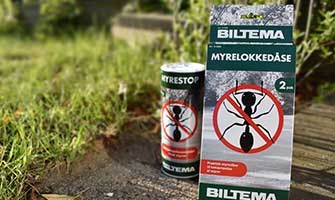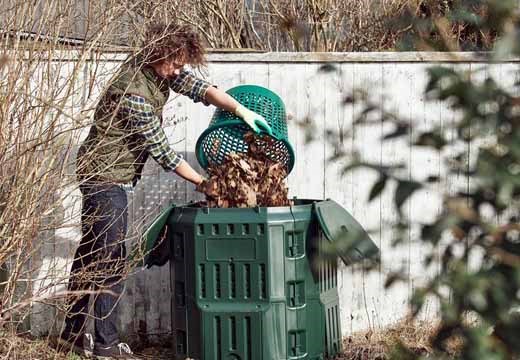Guide: Attract Insects to Your Garden with Insect Hotels and Plants
Published 2024.05.01
What is an insect hotel?
An insect hotel is a collection of different natural materials, such as leaves, twigs, and pine cones, designed to attract and house a wide range of useful insects in your garden. Insects can hide, hibernate, find food, and breed inside the insect hotel. It is important to have insects in your garden, since they help with pollination, control pests, such as aphids, and generally ensure a healthy garden. If you want to get good advice on how to make your own insect hotel, continue reading on this page.
Take care of insects using insect hotels
By setting up an insect hotel, you create an environment that promotes biodiversity while helping protect endangered insect species. All over the world, various insects such as butterflies, bees, and beetles are threatened, so it is important that global efforts are made to stop this. Insect hotels are just one solution that you can do at home. Wild gardens, organic planting and cultivation, and more, can also help rescue them from extinction.
Why are insects endangered?
Modern horticulture is one of the reasons the survival of our many insects is under threat. We minimise and simplify our gardens into sterile lawns that leave very little space for planting for the necessary insects. In addition, their environments are increasingly polluted with fertilisers, pesticides, and other chemicals. We typically use these chemicals to keep our gardens neat and free of pests, or we use them to grow our vegetable gardens.
Climate change and invasive species also greatly increase the threat to these fragile creatures. It is therefore important that we change our practices and find more sustainable ways to care for our gardens.
Attract more bees with a bee hotel
Compared to 10 years ago, wild bees have less space to nest and lay their eggs. But with some effort and a bit of luck, your bee hotel can be exactly what attracts some of the wild species.
Once a bee has chosen your hotel as a home, it will be inhabited for a full 12 months - from the time bees lay eggs in the spring until the new bees hatch from their breeding cells the following spring. You should therefore ideally start construction of your bee hotel in the spring.
How to make a bee hotel
A bee hotel should preferably be placed 100-120 centimetres above the ground, so that it is within easy reach of bees. It’s a good idea to make several small bee hotels rather than one large one, since invasive parasites can move into the large bee hotels and spread quickly.
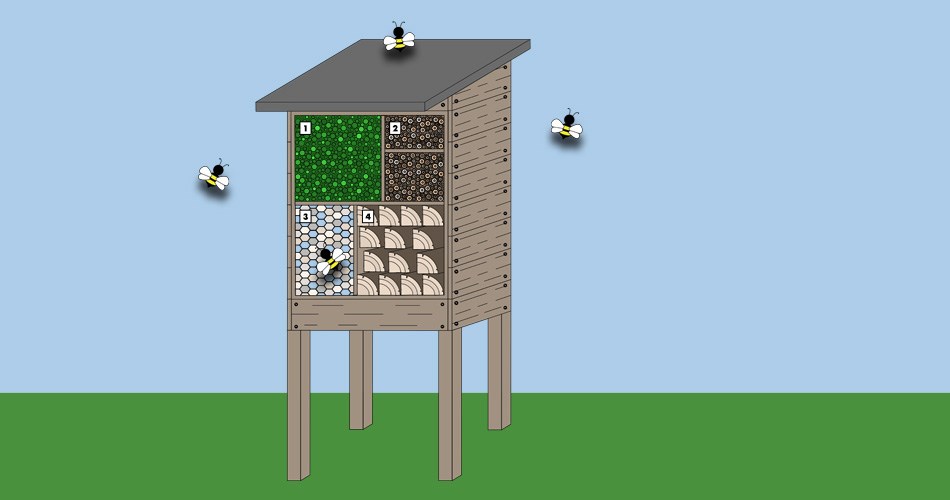
Elaboration of the numbers in the image:
When building your bee hotel, you will need:
- A wooden box: Bee hotels typically consist of a wooden box with several compartments at a depth of 20 centimetres. Make sure that the box has a back wall and only open on one side.
- Roof overhang: Your bee hotel should have a roof overhang to protect the materials from rain. Alternatively, you can also place the insect hotel under the roof overhang of a shed our house.
- Materials for the insects: The box must be filled with materials that attract wild bees. For example, bamboo canes, pieces of wood, branches, as well as sand, clay, and soil that have been kneaded together and which dry when placed correctly. Also, be sure to sand down the sharp ends of the materials so that they do not injure the bees.
- Chicken mesh: It’s a good idea to use chicken mesh at the front of the insect hotel to hold the materials in place.
Bees also love wild gardens
Attracting more bees to your garden is all about creating the right environment for them. Bees are attracted to plants with lots of pollen and nectar, such as lavender, purple coneflower, and cornflower. These plants provide the bees with the nutrition they need to survive and breed. It’s therefore good to plant more flowers in your garden, or even dedicate part of your garden to the ‘wild garden’ concept.
If you don’t already know about wild gardens, then here is a brief introduction. A wild garden is a garden designed to mimic nature’s own processes, create a sustainable ecosystem, and promote biodiversity. It's a garden full of life, from buzzing bees and fluttering butterflies to lush plants and colourful flowers.
Creating a wild garden has many benefits. First, it’s a great way to attract bees and other species. By planting different plants and flowers, you literally create a paradise for them. Second, a wild garden requires less maintenance than a traditional garden, and animals like that. Once established, the ecosystem will essentially take care of itself. Although the term ‘wild garden’ sounds disorderly, a wild garden can be the most beautiful sight during spring and summer. Imagine a flower meadow with lots of colours, shapes, textures, and life – in your own garden. Doesn’t that sound wonderful?
You can also dedicate a specific area to creating a wild garden so that your entire garden is not swallowed up by the wildness. This will allow you to keep a bit of order amongst the chaos. All you need to do is invest in some mixed flower seeds and sprinkle them in the chosen area. Do this in April or May, and watch beautiful flowers grow after just a few weeks.
How to attract insects with an insect hotel
An insect hotel is ideal for ladybugs, spiders, earthworms, beetles, earwigs, and woodlice. Which of these species will visit depends on the materials you use in the insect hotel. So you can choose which particular insects you want to attract, and you can even use some materials you have lying around. Make sure the materials are not sprayed, varnished, or treated with chemicals.
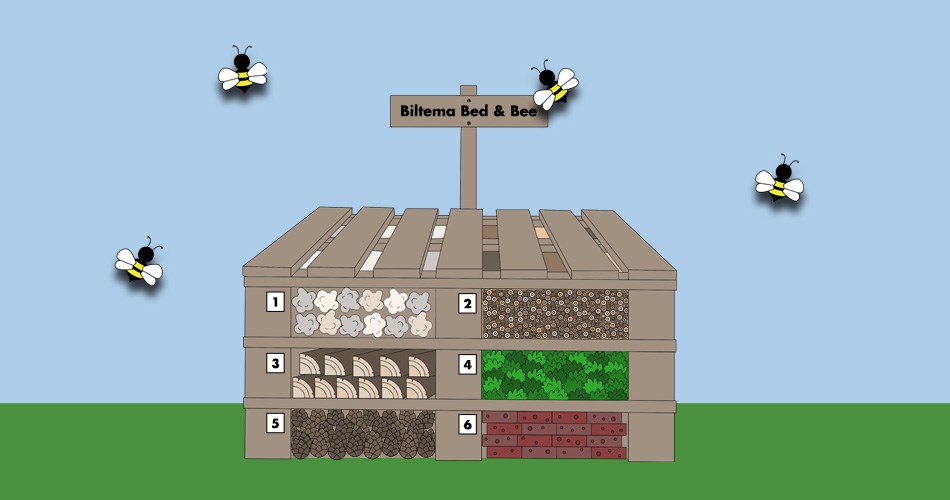
Elaboration of the image:
Place the "hotel itself in a moist place with shade and directly on the ground.
In principle, there are no limits to how it can be designed - it all comes down to your own creativity. But below we give you some suggestions on how to make your insect hotel.
- Design: If you have pallets lying around, you can use them to build a frame with different sections. Pallets are good for this, since they already have the section divisions. But you can also use a wooden box or similar.
- Materials: You can use moss, pine cones, bark, leaves, hay, branches, pieces of wood, or wool. Most of it can be found in the forest and therefore costs nothing.
- Fill the sections: Fill the sections with as many different materials as possible if you want to attract many species. However, do not fill the spaces to the brim. Leave gaps and crevices between the materials so that the insects can easily enter and hide.
Buy an insect hotel at Biltema
If you are not into DIY projects, then you can easily get rich insect life in the garden without having to make a homemade insect hotel. At Biltema we have insect hotels in different models at a good price that can attract many different insects. These can be a good start to the project, and you can always buy one or more insect hotels. The small insect hotels also fit well into small gardens.
Mini version: Build an insect hut out of bamboo
If you want to start with a simplified version, a quick and easy insect hut may be ideal. All you need for that are bamboo sticks or some thin branches and string. Make sure the bamboo sticks are about 15-20 centimetres long, place them in a pile, and then tie them together with the string.
Where should an insect hotel be placed?
When placing your bee hotel, it is important to consider both your comfort and the well-being of insects. Although the insects contribute positively to the garden, they can be bothersome when you’re trying to enjoy your time outdoors. We therefore suggest that you place your bee hotel somewhere at the back of the garden – far away from the patio and areas you typically use. Make sure the area is sunny and well protected. Height is also important - the bee hotel should be hung 1-2 metres above the ground in order to be easily visible to the insects. Remember that a little moisture is good for the insects, but direct winds and rain should be avoided.
An insect hotel made of pallets or wooden boxes should be in contact with the ground so that the insects can enter. If you hang it too high, only flying insects will benefit from it. Insect hotels on the ground should be placed in a damp and shady area.
Does an insect hotel need maintenance?
Once you have made an insect hotel, you need to remember to maintain it. It doesn’t require much maintenance, but keep an eye out for damaged, worn, and rotten materials. If too much moisture and mould forms in the insect hotel, the materials will need to be quickly replaced. Do this at least once a year, preferably in late summer, so that the insects have a pleasant and healthy place to be. If you suddenly notice that wildlife disappears from the insect hotels, it may be a sign of an unhealthy environment.
Buy lots of garden products from Biltema
At Biltema we know that a garden is more than just an outdoor area. It is a place of relaxation, togetherness, and discovery. That’s why we offer products to help you get the most out of your garden. From insect hotels to garden furniture, we have it all.
Check out our fire pits for the fire place, which create a cosy atmosphere and allow you to cook outdoors – perfect for late summer evenings with family and friends. And with our good garden lighting, you can enjoy your outdoor space even after dark.
Are you looking for good comfort on your patio? Our garden furniture is both stylish and comfortable, so you can relax and enjoy a good book, a cup of coffee, or a chat with a loved one. And if you’ve got a green thumb, you’ll love our gardening tools and equipment for planting and growing in the garden. With these, you can grow your own fresh vegetables, right in your own backyard.

